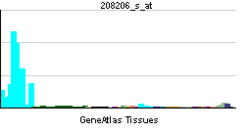RASGRP2
RAS guanyl-releasing protein 2 is a protein that in humans is encoded by the RASGRP2 gene.[1][2]
The protein encoded by this gene is a brain-enriched nucleotide exchanged factor that contains an N-terminal GEF domain, 2 tandem repeats of EF-hand calcium-binding motifs, and a C-terminal diacylglycerol/phorbol ester-binding domain. This protein can activate small GTPases, including RAS and RAP1/RAS3. The nucleotide exchange activity of this protein can be stimulated by calcium and diacylglycerol. Two alternatively spliced transcript variants of this gene, encoding distinct isoforms, have been reported.[2]
Clinical significance
Mutations in RASGRP2 are associated with severe bleeding .[3]
References
- ↑ Kawasaki H, Springett GM, Toki S, Canales JJ, Harlan P, Blumenstiel JP, Chen EJ, Bany IA, Mochizuki N, Ashbacher A, Matsuda M, Housman DE, Graybiel AM (Nov 1998). "A Rap guanine nucleotide exchange factor enriched highly in the basal ganglia". Proc Natl Acad Sci U S A 95 (22): 13278–83. doi:10.1073/pnas.95.22.13278. PMC 23782. PMID 9789079.
- 1 2 "Entrez Gene: RASGRP2 RAS guanyl releasing protein 2 (calcium and DAG-regulated)".
- ↑ Canault, M; Ghalloussi, D; Grosdidier, C; Guinier, M; Perret, C; Chelghoum, N; Germain, M; Raslova, H; Peiretti, F; Morange, P. E.; Saut, N; Pillois, X; Nurden, A. T.; Cambien, F; Pierres, A; Van Den Berg, T. K.; Kuijpers, T. W.; Alessi, M. C.; Tregouet, D. A. (2014). "Human CalDAG-GEFI gene (RASGRP2) mutation affects platelet function and causes severe bleeding". Journal of Experimental Medicine 211: 1349–62. doi:10.1084/jem.20130477. PMID 24958846.
Further reading
- Kedra D, Seroussi E, Fransson I, et al. (1997). "The germinal center kinase gene and a novel CDC25-like gene are located in the vicinity of the PYGM gene on 11q13.". Hum. Genet. 100 (5-6): 611–9. doi:10.1007/s004390050562. PMID 9341881.
- Clyde-Smith J, Silins G, Gartside M, et al. (2000). "Characterization of RasGRP2, a plasma membrane-targeted, dual specificity Ras/Rap exchange factor.". J. Biol. Chem. 275 (41): 32260–7. doi:10.1074/jbc.M006087200. PMID 10918068.
- Guo FF, Kumahara E, Saffen D (2001). "A CalDAG-GEFI/Rap1/B-Raf cassette couples M(1) muscarinic acetylcholine receptors to the activation of ERK1/2.". J. Biol. Chem. 276 (27): 25568–81. doi:10.1074/jbc.M101277200. PMID 11292831.
- Toki S, Kawasaki H, Tashiro N, et al. (2001). "Guanine nucleotide exchange factors CalDAG-GEFI and CalDAG-GEFII are colocalized in striatal projection neurons.". J. Comp. Neurol. 437 (4): 398–407. doi:10.1002/cne.1291. PMID 11503142.
- Eto K, Murphy R, Kerrigan SW, et al. (2002). "Megakaryocytes derived from embryonic stem cells implicate CalDAG-GEFI in integrin signaling.". Proc. Natl. Acad. Sci. U.S.A. 99 (20): 12819–24. doi:10.1073/pnas.202380099. PMC 130543. PMID 12239348.
- Strausberg RL, Feingold EA, Grouse LH, et al. (2003). "Generation and initial analysis of more than 15,000 full-length human and mouse cDNA sequences.". Proc. Natl. Acad. Sci. U.S.A. 99 (26): 16899–903. doi:10.1073/pnas.242603899. PMC 139241. PMID 12477932.
- Ota T, Suzuki Y, Nishikawa T, et al. (2004). "Complete sequencing and characterization of 21,243 full-length human cDNAs.". Nat. Genet. 36 (1): 40–5. doi:10.1038/ng1285. PMID 14702039.
- Katagiri K, Shimonaka M, Kinashi T (2004). "Rap1-mediated lymphocyte function-associated antigen-1 activation by the T cell antigen receptor is dependent on phospholipase C-gamma1.". J. Biol. Chem. 279 (12): 11875–81. doi:10.1074/jbc.M310717200. PMID 14702343.
- Kimura K, Wakamatsu A, Suzuki Y, et al. (2006). "Diversification of transcriptional modulation: large-scale identification and characterization of putative alternative promoters of human genes.". Genome Res. 16 (1): 55–65. doi:10.1101/gr.4039406. PMC 1356129. PMID 16344560.
External links
- RASGRP2 human gene location in the UCSC Genome Browser.
- RASGRP2 human gene details in the UCSC Genome Browser.
This article is issued from Wikipedia - version of the Wednesday, September 02, 2015. The text is available under the Creative Commons Attribution/Share Alike but additional terms may apply for the media files.

